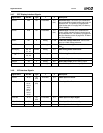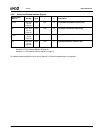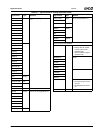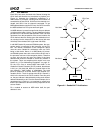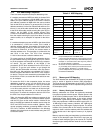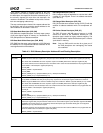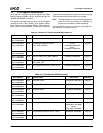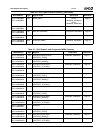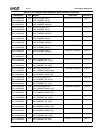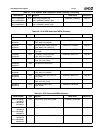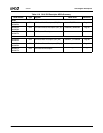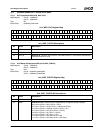
48 AMD Geode™ LX Processors Data Book
GeodeLink™ Interface Unit
33234H
Each memory request is compared against all the P2D
descriptors. If the memory request does not hit in any of
the descriptors, the request is sent to the subtractive port. If
the memory requests hit more than one descriptor, the
results are undefined. The software must provide a consis-
tent non-overlapping address map.
The way each descriptor checks if the request address hits
its descriptor and how to route the request address to the
device address is described in Table 4-3.
P2D Base Mask Descriptor (P2D_BM)
P2D_BM is the simplest descriptor. It usually maps a power
of two size aligned region of memory to a destination ID.
P2D_BM performs no address translation.
P2D Base Mask Offset Descriptor (P2D_BMO)
P2D_BMO has the same routing features as P2D_BM with
the addition of a 2s complement address translation to the
most-significant bits of the address.
P2D Range Descriptor (P2D_R)
P2D_R maps a range of addresses to a device that is NOT
a power of 2 size aligned. There is no address translation
(see Table 4-3).
P2D Range Offset Descriptor (P2D_RO)
P2D_RO has the same address routing as P2D_R with the
addition of address translation with a 2s complement off-
set.
P2D Swiss Cheese Descriptor (P2D_SC)
The P2D_SC maps a 256 KB region of memory in 16 KB
chunks to a device or the subtractive decode port. The
descriptor type is useful for legacy address mapping. The
Swiss cheese feature implies that the descriptor is used to
“poke holes” in memory.
Note: Only one P2D can hit at a time for a given port. If
the P2D descriptors are overlapping, the results
are undefined.
Table 4-3. GLIU Memory Descriptor Address Hit and Routing Description
Descriptor Function Description
P2D_BM,
P2D_BMO
Checks that the physical address supplied by the device’s request on address bits [31:12] with a logical AND with
PMASK bits of the descriptor register bits [19:0] are equal to the PBASE bits on the descriptor register (bits [39:20]).
Also checks that the BIZZARO bit of the request is equal to the PCMP_BIZ bit of the descriptor register bit [60].
If the above matches, then the descriptor has a hit condition and it routes the received address to the programmed des-
tination PDID1 of the descriptor register (bits [63:61]).
For P2D_BM:
DEVICE_ADDR = request address
For P2D_BMO:
DEVICE_ADDR [31:12] = [request address [31:12] + descriptor POFFSET]
DEVICE_ADDR [11:0] = request address [11:0]
P2D_R,
P2D_RO
Checks that the physical address supplied by the device’s request on address bits [31:12] are within the range speci-
fied by PMIN and PMASK field bits [39:20] and [19:0], respective of the descriptor register. PMIN is the minimum
address range and PMAX is the maximum address range.The condition is: PMAX > physical address [31:12] > PMIN.
Also checks that the BIZZARO bit of the request is equal to the PCMP_BIZ bit of the descriptor register bit [60].
If the above matches, then the descriptor has a hit condition and routes the received address to the programmed des-
tination ID, PDID1 of the descriptor register (bits [63:61]).
For P2D_R:
DEVICE_ADDR = request address
For P2D_RO:
DEVICE_ADDR [31:12] = [request address [31:12] + descriptor POFFSET]
DEVICE_ADDR [11:0] = request address [11:0]
P2D_SC Checks that the physical address supplied by the device’s request on address bits [31:18] are equal to the PBASE field
of descriptor register bits [13:0] and that the enable write or read conditions given by the descriptor register fields WEN
and REN in bits [47:32] and [31:16], respectively matches the request type and enable fields given on the physical
address bits [17:14] of the device’s request.
If the above matches, then the descriptor has a hit condition and routes the received address to the programmed des-
tination ID, PDID1 field of the descriptor register bits [63:61].
DEVICE_ADDR = request address




